Tainan (台南 Táinán) is in in Southern Taiwan and the oldest city in Taiwan.
Tainan is famous for its temples, historic buildings and snack food. Located on the southwestern coast of the country, it has had a complicated past, first starting as a Dutch colony before passing through Chinese warlords, Japanese occupiers and then into Kuomintang hands. This rich history and heady mix of traditional folk culture gives Tainan far more character than the bigger Taiwanese cities, and is a good contrast to the international Taipei. It may be even more under-appreciated compared to the current capital, but is well worth a stop on a round-island trip for a quintessentially Taiwanese experience for both stomach and soul.
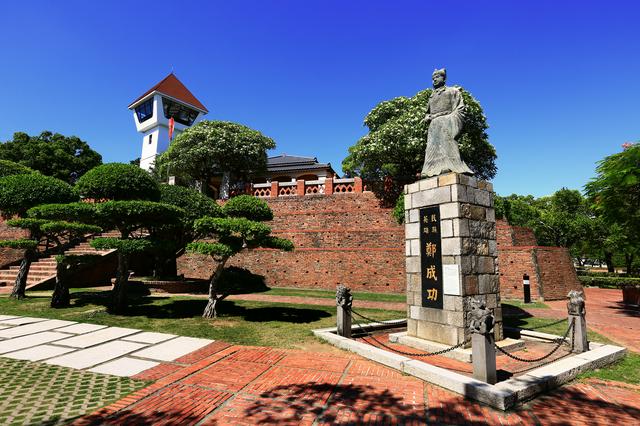 To truly understand the history of modern Taiwan is to trace its beginnings to Tainan. Tainan (and the start of a non-agrarian Taiwan) began in 1624 when the Dutch East India Company set up a colonial base in the Anping District (安平區 Ānpíng qū). The island of Formosa was strategically placed along major trade routes, and so the Dutch were keen to start building up a trading post and fort known as Fort Zeelandia. They were soon besieged by Ming loyalists led by Koxinga, and their surrender ended 38 years of Dutch colonial rule, bringing Taiwan under Han Chinese influence. However, Koxinga's own rule was similarly short-lived as he died four months after the takeover, yet he lives on as a local folk hero and religious icon of sorts. His grandson gave up control to the Qing dynasty, and Tainan was made the capital of Taiwan County of Fujian Province. However, Tainan, and Taiwan as a whole continued to be a Chinese backwater until the Second Opium War in 1858 forced the reopening of Anping port to foreigners, with British merchants stimulating growth in the city. Tainan lost its status as capital after Taiwan was declared a separate province in 1885, and the Qing government deciding to set up the provincial capital in Taipei instead.
To truly understand the history of modern Taiwan is to trace its beginnings to Tainan. Tainan (and the start of a non-agrarian Taiwan) began in 1624 when the Dutch East India Company set up a colonial base in the Anping District (安平區 Ānpíng qū). The island of Formosa was strategically placed along major trade routes, and so the Dutch were keen to start building up a trading post and fort known as Fort Zeelandia. They were soon besieged by Ming loyalists led by Koxinga, and their surrender ended 38 years of Dutch colonial rule, bringing Taiwan under Han Chinese influence. However, Koxinga's own rule was similarly short-lived as he died four months after the takeover, yet he lives on as a local folk hero and religious icon of sorts. His grandson gave up control to the Qing dynasty, and Tainan was made the capital of Taiwan County of Fujian Province. However, Tainan, and Taiwan as a whole continued to be a Chinese backwater until the Second Opium War in 1858 forced the reopening of Anping port to foreigners, with British merchants stimulating growth in the city. Tainan lost its status as capital after Taiwan was declared a separate province in 1885, and the Qing government deciding to set up the provincial capital in Taipei instead.
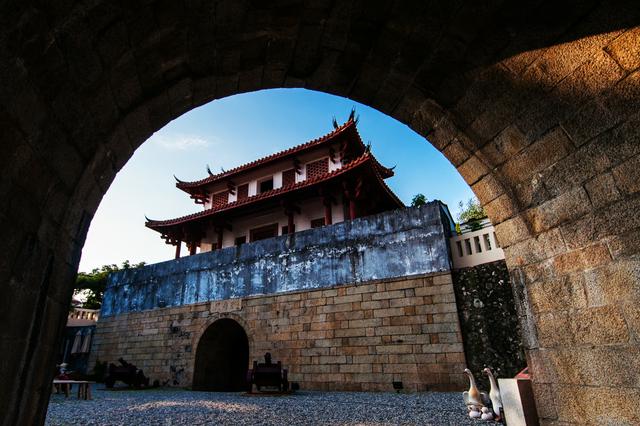 Upon secession of Taiwan to Japan after the Sino-Japanese War in 1895, city leaders tried to declare independence (perhaps the first attempt at formal self-governance) although that failed and anti-Japanese sentiment grew into the Tapani Incident in 1915, when Aboriginal and Han Chinese fighters stormed several police stations in Tainan county. The armed uprising was brutally crushed, marking a turning point in relations between the local population and their occupiers as Japan started policies to peacefully integrate Taiwan into the nascent Japanese Empire. Modern infrastructure and urban planning transformed Tainan, befitting the largest Taiwanese settlement and capital at the time. The odd impressive colonial building can still be found around the city, standing out against other less inspired post-war architecture.
Upon secession of Taiwan to Japan after the Sino-Japanese War in 1895, city leaders tried to declare independence (perhaps the first attempt at formal self-governance) although that failed and anti-Japanese sentiment grew into the Tapani Incident in 1915, when Aboriginal and Han Chinese fighters stormed several police stations in Tainan county. The armed uprising was brutally crushed, marking a turning point in relations between the local population and their occupiers as Japan started policies to peacefully integrate Taiwan into the nascent Japanese Empire. Modern infrastructure and urban planning transformed Tainan, befitting the largest Taiwanese settlement and capital at the time. The odd impressive colonial building can still be found around the city, standing out against other less inspired post-war architecture.
After the island was handed back to the Nationalists and the communists retreated to the mainland, the capital was shifted to Taipei, and Tainan residents were harshly treated under the slightest suspicion of opposition to the new regime instituted by Chiang Kai-shek. Tainan and the rest of southern Taiwan remain fairly pro-independence to this day, since they have not actively thought themselves a part of China for the last century or so.
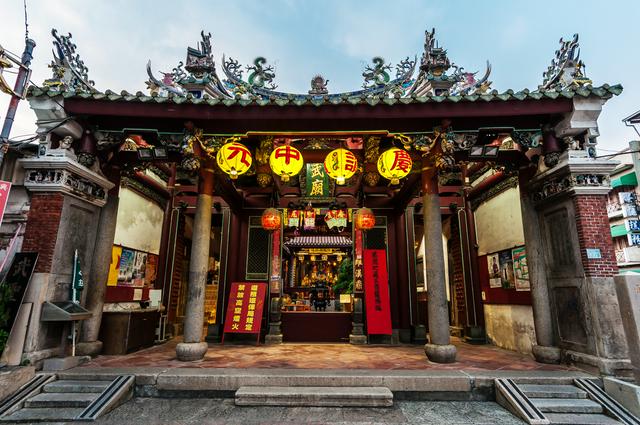 The city is the fifth largest city on the island after New Taipei, Kaohsiung, Taichung and Taipei with a population of over 1.8 million. For a city of its size by population, Tainan's size by land area is exceptional. Very few buildings are more than 5 to 6 stories in height and most are between two and three stories. Instead, wandering the older winding back alleys holds a lot of charm. Tainan is also extraordinary for its number of temples and shrines, Buddhist and Taoist, large and small, and you'll likely find one hidden around every other corner.
The city is the fifth largest city on the island after New Taipei, Kaohsiung, Taichung and Taipei with a population of over 1.8 million. For a city of its size by population, Tainan's size by land area is exceptional. Very few buildings are more than 5 to 6 stories in height and most are between two and three stories. Instead, wandering the older winding back alleys holds a lot of charm. Tainan is also extraordinary for its number of temples and shrines, Buddhist and Taoist, large and small, and you'll likely find one hidden around every other corner.
Modern Tainan is centered on the local TRA train station and Zhongshan Road, which runs through West Central District, though Anping District is the historical heart of Tainan. Anping is home to the Anping Old Fort (安平古堡;Ānpíng gu bǎo), the Anping Tree House (安平樹屋 Ānpíng shù wū) (a warehouse with massive banyan trees growing out of it), and numerous restaurants and food stalls. Qigu District in the northeast is noted for its history of salt production and the district's salt fields are also a popular attraction. Yanshui District is infamous for its notoriously fiery fireworks festival. Beyond the city center, the surrounding region is one of the major agricultural centers in Taiwan, and the amount of fresh produce may have inspired much of Tainan's snack food culture.
Like other Taiwanese cities, most people in Tainan, including taxi drivers, cannot speak English well (except for high school and college students), though some of the older generation can converse in Japanese. However, to help visitors get around, there are free tri-lingual (Chinese, English and Japanese) map-guides available at the railway station. Hokkien or taiyu is spoken by many residents of the city, and the Tainan accent is considered the standard pronunciation for the Taiwanese dialect.
At first glimpse, Tainan may seem all gray buildings with an alarming number of scooters, but thankfully it doesn't take long to discover its charms. Historical buildings and temples are mostly found in three main clusters: near Chih-kan Tower and on Zhongzheng Road, which used to be within old city walls during the Qing Dynasty, and in Anping District.
There is a combined ticket available for NT$150, covering all 5 important sites; Anping Tree House, Anping Fort, Chih-kan Tower, Golden Castle, and museum. So, you would safe NT$100.
- Anping Fort. Daily 08:30–17:30. In the early 17th century, European seafarers came to Asia to trade and develop colonial outposts. In 1624, the Dutch occupied today's Anping and took ten years to build a fort named "Fort Zeelandia." After 1662, because Koxinga and his son lived here, it was named "King Castle," "Anping Castle" as well as "Taiwan Castle." The Japanese rebuilt it and named it "Anping Old Fort." Today, the only Dutch remains are the ruins of a semicircular bulwark and a section of the outer fort's brick wall; the root of an old banyan tree on the wall remains a witness to the fort's long history. Its commanding views of the ocean make it a popular place to watch the sunset. Nevertheless, the fort itself is not that impressing, and neither is the view from the tower during the day. Also, there is not much space in the tower, so it is questionable that many people will be able to enjoy the sunset. Hence, you could skip it for Anping Tree House instead. NT$50.
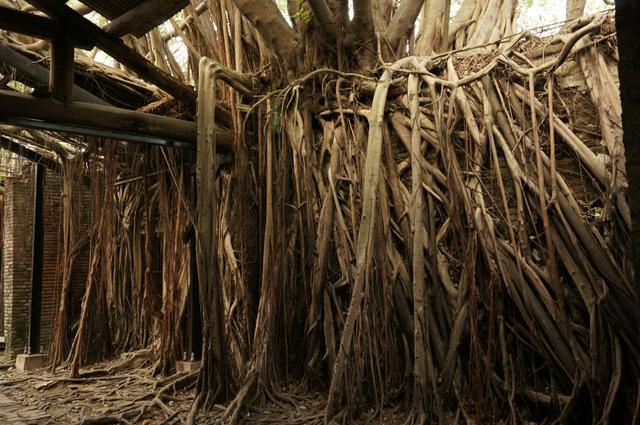
- Anping Tree House, 108 Fort St., Anping District (entrance through the back door of Old Tait & Co. Merchant House). Daily 08:30-18:00. Anping Tree House was built as the warehouse of Tait & Co. During the Japanese Occupation it was the office and warehouse of the Japan Salt Company. After World War II, the salt industry in Anping declined, and this area was abandoned. The aerial roots and branches of banyan trees wrapped around the building, combined with the soil, red brick and partial concrete wall creates an unusual sight. NT$50.
- Chih-kan Tower, 212 Sec. 2, Min-Tsu Rd., Central District. Daily 08:30-21:00. Chihkan Tower s the landmark of Tainan and its most famous historic site. In 1653 the Dutch built "Fort Providentia" in the area, and the Chinese named it "Tower of Savages" or "Tower of Red-haired Barbarians." Even though Chihkan Tower has survived different historical periods, it retains its rich and graceful architectural aspects. Crammed with various kinds of steles, stone horses, weight lifting rocks, stone weights, ponds with colorful fish and nine stone tortoises carrying royal stele carved in Chinese and Manchurian, the courtyard looks like an outdoor museum. Chihkan Tower is particularly attractive at night. NT$50.
- Eternal Golden Fortress, 16 Nanwen, Anping District. Daily 08:30-17:30. A 19th-century coastal fortress, it was built during the Qing dynasty and armed with cannons to defend against the threat of Japanese invasion. Bricks from the remains of Fort Zeelandia were used during the fort's construction. The squarish fort feels like a very big park aside from its thick walls and gate tunnel, and paddle boats are even available for rent in the moat surrounding the fort. There are sometimes musical events and performances in the evening. NT$50.
- National Cheng Kung University. Tu-Su 10:00-17:00. Free.
- Great South Gate.
Anping Fort. Daily 08:30–17:30. In the early 17th century, European seafarers came to Asia to trade and develop colonial outposts. In 1624, the Dutch occupied today's Anping and took ten years to build a fort named "Fort Zeelandia." After 1662, because Koxinga and his son lived here, it was named "King Castle," "Anping Castle" as well as "Taiwan Castle." The Japanese rebuilt it and named it "Anping Old Fort." Today, the only Dutch remains are the ruins of a semicircular bulwark and a section of the outer fort's brick wall; the root of an old banyan tree on the wall remains a witness to the fort's long history. Its commanding views of the ocean make it a popular place to watch the sunset. Nevertheless, the fort itself is not that impressing, and neither is the view from the tower during the day. Also, there is not much space in the tower, so it is questionable that many people will be able to enjoy the sunset. Hence, you could skip it for Anping Tree House instead. NT$50.
Anping Tree House, 108 Fort St., Anping District (entrance through the back door of Old Tait & Co. Merchant House). Daily 08:30-18:00. Anping Tree House was built as the warehouse of Tait & Co. During the Japanese Occupation it was the office and warehouse of the Japan Salt Company. After World War II, the salt industry in Anping declined, and this area was abandoned. The aerial roots and branches of banyan trees wrapped around the building, combined with the soil, red brick and partial concrete wall creates an unusual sight. NT$50.
Chih-kan Tower, 212 Sec. 2, Min-Tsu Rd., Central District. Daily 08:30-21:00. Chihkan Tower s the landmark of Tainan and its most famous historic site. In 1653 the Dutch built "Fort Providentia" in the area, and the Chinese named it "Tower of Savages" or "Tower of Red-haired Barbarians." Even though Chihkan Tower has survived different historical periods, it retains its rich and graceful architectural aspects. Crammed with various kinds of steles, stone horses, weight lifting rocks, stone weights, ponds with colorful fish and nine stone tortoises carrying royal stele carved in Chinese and Manchurian, the courtyard looks like an outdoor museum. Chihkan Tower is particularly attractive at night. NT$50.
Eternal Golden Fortress, 16 Nanwen, Anping District. Daily 08:30-17:30. A 19th-century coastal fortress, it was built during the Qing dynasty and armed with cannons to defend against the threat of Japanese invasion. Bricks from the remains of Fort Zeelandia were used during the fort's construction. The squarish fort feels like a very big park aside from its thick walls and gate tunnel, and paddle boats are even available for rent in the moat surrounding the fort. There are sometimes musical events and performances in the evening. NT$50.
National Cheng Kung University. Tu-Su 10:00-17:00. Free.
Great South Gate.
Old Taoist religious customs, many of which have been wiped out elsewhere, are cherished and not forgotten here.
- Sacrificial Rites Martial Temple.
- Confucius Temple. A serene destination surrounded by a small park. Explore the temple, then go to the incredibly popular shaved-ice store right on the opposite side. NT$25.
- Koxinga Shrine, 152 Kaishan Rd, West Central District. Daily 08:30-21:00. A small shrine dedicated to Koxinga, with plaques and information about his life. Locally known as Zheng Chenggong, Koxinga is an intriguing iconic hero of Taiwan, symbolic in different ways to different people and his image bent to fit whoever is in charge. He was a pirate to the Dutch, a brave and loyal general to the Chinese, a brutal conqueror to the Aboriginal tribes and a favored son to the Japanese through his mother. He was even a beacon of hope to the KMT in their aims to reclaim the mainland, though perhaps not the best example for them. The garden is quiet and serene, and a statue of Zheng Chenggong on horseback guards the entrance. Free.
Sacrificial Rites Martial Temple.
Confucius Temple. A serene destination surrounded by a small park. Explore the temple, then go to the incredibly popular shaved-ice store right on the opposite side. NT$25.
Koxinga Shrine, 152 Kaishan Rd, West Central District. Daily 08:30-21:00. A small shrine dedicated to Koxinga, with plaques and information about his life. Locally known as Zheng Chenggong, Koxinga is an intriguing iconic hero of Taiwan, symbolic in different ways to different people and his image bent to fit whoever is in charge. He was a pirate to the Dutch, a brave and loyal general to the Chinese, a brutal conqueror to the Aboriginal tribes and a favored son to the Japanese through his mother. He was even a beacon of hope to the KMT in their aims to reclaim the mainland, though perhaps not the best example for them. The garden is quiet and serene, and a statue of Zheng Chenggong on horseback guards the entrance. Free.
- National Museum of Taiwan History, 250, Changhe Rd Sec 1, Annan District (take bus 18 from Tainan Railway Station or bus 20 from Yongkang Railway Station, +886 6 3568889. Tu-Su 09:00-17:00. The museum covers a broad overview of Taiwan's history from prehistoric beginnings to the present, illustrating various eras with large-scale interactive displays and dioramas. Temporary exhibits focus more of the museum's historical artifacts. Most of the exhibitions have clear English explanations. Besides the museum, the building sits in a large park and is architecturally interesting, focusing on harmonious integration with the environment and housing a huge wall of solar panels that generates enough electricity to power the exhibition hall. NT$80.
- National Museum of Taiwanese Literature. Located in a restored colonial-era Japanese building, even with the limited English on display this museum is fascinating. The coffee shop is good too.
- Chimei Museum, 66 Wenhua Rd Sec. 2, Rende District (Bao'an TRA Station. Tu-Su 09:30-17:30. Started by a private collector who has a vast collection of violins, many of them antique in nature and made by masters like Antonio Stradivari and Nicolo Amati. There's also various exhibits about Western art, weaponry and natural history. The building and surrounding park are astonishing in their incongruence and could have been transported entirely from classical Europe. NT$200.
National Museum of Taiwan History, 250, Changhe Rd Sec 1, Annan District (take bus 18 from Tainan Railway Station or bus 20 from Yongkang Railway Station, +886 6 3568889. Tu-Su 09:00-17:00. The museum covers a broad overview of Taiwan's history from prehistoric beginnings to the present, illustrating various eras with large-scale interactive displays and dioramas. Temporary exhibits focus more of the museum's historical artifacts. Most of the exhibitions have clear English explanations. Besides the museum, the building sits in a large park and is architecturally interesting, focusing on harmonious integration with the environment and housing a huge wall of solar panels that generates enough electricity to power the exhibition hall. NT$80.
National Museum of Taiwanese Literature. Located in a restored colonial-era Japanese building, even with the limited English on display this museum is fascinating. The coffee shop is good too.
Chimei Museum, 66 Wenhua Rd Sec. 2, Rende District (Bao'an TRA Station. Tu-Su 09:30-17:30. Started by a private collector who has a vast collection of violins, many of them antique in nature and made by masters like Antonio Stradivari and Nicolo Amati. There's also various exhibits about Western art, weaponry and natural history. The building and surrounding park are astonishing in their incongruence and could have been transported entirely from classical Europe. NT$200.
- Qigu Salt Mountain
- Jingzaijiao Tile-paved Salt Fields
- Caoshan Moon World (草山月世界), Zuozhen District. An interesting region of mud hills and badlands surrounded by thick bamboo forest and some tropical fruit farms. Take the Green bus from Tainan train station to Xinhua (新化), where it's worth wandering around to grab a bite and see the sights. Then take the Green 13 branch line in the direction of Zuozhen (左鎮) and get out at Ganglin (岡林). Walk past the restaurant and the church then turn right and keep walking. A scooter would make this trip much easier, but keep your eyes open for photo ops along the road. As of June 2017 the published bus schedule is not correct, so make sure to confirm with the staff at Xinhua bus terminal.
Caoshan Moon World (草山月世界), Zuozhen District. An interesting region of mud hills and badlands surrounded by thick bamboo forest and some tropical fruit farms. Take the Green bus from Tainan train station to Xinhua (新化), where it's worth wandering around to grab a bite and see the sights. Then take the Green 13 branch line in the direction of Zuozhen (左鎮) and get out at Ganglin (岡林). Walk past the restaurant and the church then turn right and keep walking. A scooter would make this trip much easier, but keep your eyes open for photo ops along the road. As of June 2017 the published bus schedule is not correct, so make sure to confirm with the staff at Xinhua bus terminal.
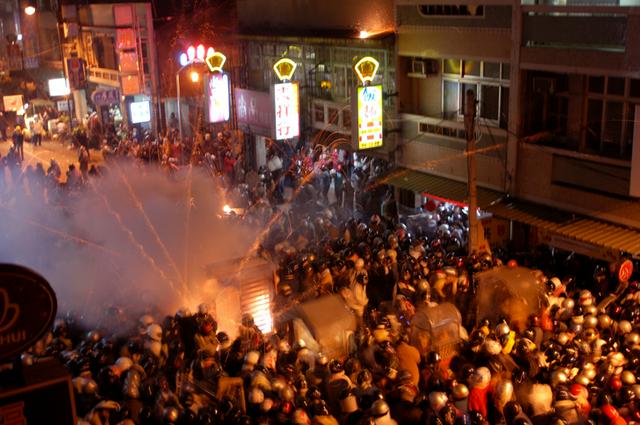
- Tainan Park, GongYuan North Rd. Beautiful park in a central part of the city. Great for a relaxing walk or a stay of a few hours. It has many beautiful trees, flowers and a pond.
- Uni-President Lions Baseball, Tainan Municipal Baseball Stadium. Baseball games in Taiwan are lively and light-hearted with a lot of chanting and cheering in unison. Beer and barbecues are even allowed in the bleachers. Stadiums are divided into home and away crowd, infield or outfield. Wear green and orange to blend in with the home crowd. The team does travel between stadiums for games, so check the CPBL schedule. The season runs from March to June and July to September. NT$150-300.
- Sicao Lushe Tunnel, 360 Dazhong Rd, Annan District. Found in Taijiang National Park, there are two boat rides to observe the marine life and migrant birds of a mangrove swamp reserve. The rare black-faced spoonbill can be seen here. The shorter route takes about 30 minutes, while the longer one is about 70 minutes. Queues are roughly the same time as the boat rides themselves, and weekday boat schedules only run a few times per day. NT$150-200.
- Yanshui Beehive Fireworks Festival. 15th day of the first lunar month. Meant to chase off evil spirits, fireworks are piled into a structure resembling a beehive and set off at street level, which makes it a racuous celebration that requires full-face helmets and fire-retardant jackets for participation.
Tainan Park, GongYuan North Rd. Beautiful park in a central part of the city. Great for a relaxing walk or a stay of a few hours. It has many beautiful trees, flowers and a pond.
Uni-President Lions Baseball, Tainan Municipal Baseball Stadium. Baseball games in Taiwan are lively and light-hearted with a lot of chanting and cheering in unison. Beer and barbecues are even allowed in the bleachers. Stadiums are divided into home and away crowd, infield or outfield. Wear green and orange to blend in with the home crowd. The team does travel between stadiums for games, so check the CPBL schedule. The season runs from March to June and July to September. NT$150-300.
Sicao Lushe Tunnel, 360 Dazhong Rd, Annan District. Found in Taijiang National Park, there are two boat rides to observe the marine life and migrant birds of a mangrove swamp reserve. The rare black-faced spoonbill can be seen here. The shorter route takes about 30 minutes, while the longer one is about 70 minutes. Queues are roughly the same time as the boat rides themselves, and weekday boat schedules only run a few times per day. NT$150-200.
Yanshui Beehive Fireworks Festival. 15th day of the first lunar month. Meant to chase off evil spirits, fireworks are piled into a structure resembling a beehive and set off at street level, which makes it a racuous celebration that requires full-face helmets and fire-retardant jackets for participation.
The areas around Zhongshan Road, Beimen Road, and the train station make up the downtown of Tainan. South of the main train station is where you can find various boutique stores that mainly focuses on Japanese fashion and sport equipment stores (a popular place to visit for local students).
- Anping Old Street. Preserved plums (酸梅 suānméi) are a popular item.
- Fuzhong Street.
- Shennong Street.
Anping Old Street. Preserved plums (酸梅 suānméi) are a popular item.
Fuzhong Street.
Shennong Street.
- Far-East Department Store, 60 Gongyuan Rd. The department store focuses more on midrange consumers. Downstairs food-court offers good selection of restaurants and Hong Kong-based supermarket Wellcome.
- Hayashi Department Store, 55 Zhongyi Rd Sec. 2. On its opening in 1932, the building boasted a then state-of-the-art elevator, which still works. It was bombed during World War II and still has bullet marks to show on the rooftop, next to its Shinto shrine. Located on what was once the richest shopping street in Tainan, the site fell into disuse until restoration of its elegant interior was completed in 2014. It is now home to another department store selling Japanese and Taiwanese food and handicrafts. Tainan Land Bank diagonally across the road from the store is also a stately Japanese-era building.
- Shinkong Mitsukoshi, 162 Zhongshan Rd. The department store focuses on both high end products and mainstream fashion. Luxurious brands such as Chanel, Hermes, Ferragamo can be found in the department store. Men's fashion includes Calvin Klein, Hugo Boss, Polo Ralph Lauren, Nautica, Esprit and more. There's also a movie theater inside. Two food courts offer various Asian, western cuisine and fast food chains. There is also a newer, more modern Shinkong Mitsukoshi at 658 Ximen Rd Section 1.
Far-East Department Store, 60 Gongyuan Rd. The department store focuses more on midrange consumers. Downstairs food-court offers good selection of restaurants and Hong Kong-based supermarket Wellcome.
Hayashi Department Store, 55 Zhongyi Rd Sec. 2. On its opening in 1932, the building boasted a then state-of-the-art elevator, which still works. It was bombed during World War II and still has bullet marks to show on the rooftop, next to its Shinto shrine. Located on what was once the richest shopping street in Tainan, the site fell into disuse until restoration of its elegant interior was completed in 2014. It is now home to another department store selling Japanese and Taiwanese food and handicrafts. Tainan Land Bank diagonally across the road from the store is also a stately Japanese-era building.
Shinkong Mitsukoshi, 162 Zhongshan Rd. The department store focuses on both high end products and mainstream fashion. Luxurious brands such as Chanel, Hermes, Ferragamo can be found in the department store. Men's fashion includes Calvin Klein, Hugo Boss, Polo Ralph Lauren, Nautica, Esprit and more. There's also a movie theater inside. Two food courts offer various Asian, western cuisine and fast food chains. There is also a newer, more modern Shinkong Mitsukoshi at 658 Ximen Rd Section 1.
Tainan is often known as "the City of Snacks" (小吃城). In addition to the wide variety of food available at night markets, the city also has an abundance of street vendors specializing in tasty and cheap dishes. Oysters in particular, are favored in Tainan, from the long association with Anping port. Try the oyster omelette (蚵仔煎 kèzǎijiān / o-a chen), and oysters and thin noodles (蚵仔麵線 kèzǎi miànxiàn / o-a mi soa~) which are cooked differently from those up north. Danzai noodles (擔仔麵 dānzǎi miàn) should not be missed either. Coffin toast (棺材板 guāncaibǎn), fried bread stuffed with various ingredients, such as chicken, beans, seafood, vegetables and milk-based sauces, was also invented here.
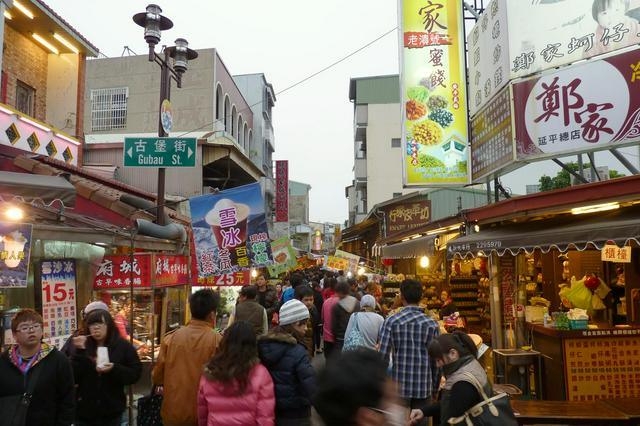
There are over two dozen night markets of various sizes in and around the city. Regardless of size, night markets all possess an abundance of stalls selling clothing, shoes, jewelry, toys, food and drink. Some even have live entertainment. Most night markets are only held on certain days of the week. Check before going.
- Garden Night Market, Haian Road, Sec. 3, between Lixian Rd and Hewei Rd. Open on Th Sa Su. The biggest and most famous open-air night market, there are tons of food stalls and game booths set up in a gigantic parking lot, but be warned that this market can get very busy (i.e. mosh pit busy) on some days.
- Da Dong Night Market, Linsen Rd, Sec. 1. Open on M Tu F. Very popular among the local university students, especially on Friday nights.
Garden Night Market, Haian Road, Sec. 3, between Lixian Rd and Hewei Rd. Open on Th Sa Su. The biggest and most famous open-air night market, there are tons of food stalls and game booths set up in a gigantic parking lot, but be warned that this market can get very busy (i.e. mosh pit busy) on some days.
Da Dong Night Market, Linsen Rd, Sec. 1. Open on M Tu F. Very popular among the local university students, especially on Friday nights.
- Du Hsiao Yueh, 16 Zhongzheng Road. A famous purveyor of dan zai mian, also known as peddlers' noodles because it was made to be sold by fishermen on the roadside. It's a small dish of noodles in pork-shrimp broth, decorated with a single shrimp and delicately balanced with a dash of garlic on top. This is the original branch, and they have opened more stores elsewhere in the country, including one on Yongkang St in Taipei and another in Taoyuan International Airport.
- Beef soup
- Eel noodles
- Rice cake (碗稞 wǎnkē)
- Don't forget to try the shrimp rolls (zhou-shi) down along the canal.
- Andi's Party Corner sells traditional Austrian food and beers, an oddity in Tainan.
Du Hsiao Yueh, 16 Zhongzheng Road. A famous purveyor of dan zai mian, also known as peddlers' noodles because it was made to be sold by fishermen on the roadside. It's a small dish of noodles in pork-shrimp broth, decorated with a single shrimp and delicately balanced with a dash of garlic on top. This is the original branch, and they have opened more stores elsewhere in the country, including one on Yongkang St in [[Taipei]] and another in Taoyuan International Airport.
Tainan has a pronounced sweet tooth, and nowhere is this more evident than in their love of sweet treats.
- Elite Cake (狀元糕 zhuàngyuan gāo)
- Imma Bakery, Shulin St.. Coffee house with breads, cakes, cookies, etc. An Israeli chef and Western style.
Imma Bakery, Shulin St.. Coffee house with breads, cakes, cookies, etc. An Israeli chef and Western style.
There aren't many shiny modern nightspots in Tainan; the city delights in retro bars instead, leveraging on its history and countless number of traditional houses to give a intimate, laidback feel. A smattering of Mandarin or Taiwanese will open more doors in terms of nightlife, otherwise it would be easier to stick to expat hangouts where the owners speak English. Some of the bars provide taxi service if you get too drunk.
Pearl milk tea (珍珠奶茶, zhēnzhū nǎichá) is a must drink in Tainan. Look out for shops where it is made directly to order! Fruit drinks and desserts are always refreshing in the sticky summer heat too.
- TCRC Bar, 117 Hsinmei St. A bar hidden in a little side alley, but probably one of the busiest in Tainan. They don't have any menus, with drinks made on request, though the standard cocktails are happily made strong.
- Seren Cafe Bar, No.26 Lane 371, Fucian Rd., +886 6-215-9377. 2PM-11PM. An intimate and laid-back cafe bar. Travel and friendship are the themes.
- Drifters Bar.
- Kinks Pub, Lane 232, No. 25 Qingnian Rd.
- Taikoo, 94 Shennong St.
TCRC Bar, 117 Hsinmei St. A bar hidden in a little side alley, but probably one of the busiest in Tainan. They don't have any menus, with drinks made on request, though the standard cocktails are happily made strong.
Seren Cafe Bar, No.26 Lane 371, Fucian Rd., +886 6-215-9377. 2PM-11PM. An intimate and laid-back cafe bar. Travel and friendship are the themes.
Drifters Bar.
Kinks Pub, Lane 232, No. 25 Qingnian Rd.
Taikoo, 94 Shennong St.
- Dirty Roger, Dongmen Rd. (close to the Railway station).Excellent small bar. Used to be very hip, still very good. Every Music imaginable.
- The Armory, Gongyuan Rd. Good for beers and sport
- Willies Second Base, for beers, sport, food and pool upstairs
- The Hangout Bar, 128-132 Gongyuan Rd (公園路, +886 6 226-4861. 18:00-02:00. Nice bar to relax, play pool and watch sports. They also have good burgers and steak, free public computer and WiFi. NT$100.
- Tin Pan Alley, Beimen Road (Across from Tainan Park. Great partly outdoor pub and bar near Tainan. Wonderful friendly owners and delicious food ranging from pizza to falafel.
The Hangout Bar, 128-132 Gongyuan Rd (公園路, +886 6 226-4861. 18:00-02:00. Nice bar to relax, play pool and watch sports. They also have good burgers and steak, free public computer and WiFi. NT$100.
Tin Pan Alley, Beimen Road (Across from Tainan Park. Great partly outdoor pub and bar near Tainan. Wonderful friendly owners and delicious food ranging from pizza to falafel.
Tainan is very safe for tourists with respect to crime. However, you should keep alert when on the roads - the Bureau of Transportation reports an average of 200 deaths and 20,000 injuries per year from traffic incidents in Tainan alone.
Adding to the constant flow of traffic in the streets, Tainan also host the greatest number of temple parades in the country which means loud fireworks at potentially any time of day. Moreover, fighter jets performing low passes over the city are a frequent occurrence every day (sometimes up to 30 times a day!), so people who are sensitive to such loud events should be wary.
- Guanziling – One of Taiwan's best-known hot spring areas.
- Fo Guang Shan – The largest and most impressive Buddhist monastery of Taiwan, just 1 hour southeast of Tainan.
- Kaohsiung – The second largest city of Taiwan, and a port city that took over Tainan's place as the Harbor City, one hour south by TRA train.
- Chiayi – The next northern city and natural jumping off point for the beautiful Alishan, e.g. by the scenic narrow-gauge Alishan Forest Railway.
- Kinmen – If Tainan is the bastion of Taiwanese identity, then Kinmen is an interesting study at the opposite end of the spectrum as a pair of islands inextricably tied to the Chinese mainland.
